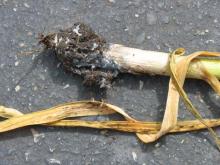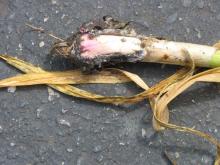Cause Sclerotium cepivorum (teleomorph: Stromatinia cepivora), a fungus. Enough sclerotia from an initially high population may survive 20 to 30 years or more in soil without the presence of an Allium host to incite unacceptable levels of disease in the next Allium crop. Only Allium spp. such as onion, leek, and shallot are attacked. Sclerotia can infect plants from 12 inches below the surface. One sclerotium can infect a group of 20 to 30 adjacent plants. Fungal activity is favored by cool soils and is restricted above 75°F. Once the disease is in a field, it is very difficult to grow Allium spp. successfully.
Symptoms Leaves decay at the base, turn yellow, wilt, and topple over. Older leaves collapse first. Roots are rotted, and the top of the plant can be pulled out of the ground easily. Fluffy white mycelium may be on remaining roots and bulb. The affected bulb may become watery, and the outer scales crack as it dries and shrinks. Small (0.02 inch) sclerotia form in affected bulb parts and on the surface, often around the neck. Sclerotia are smaller and rounder than those of the neck rot disease.
Cultural control Idaho, Oregon, and Washington laws forbid importing cloves, bulbs, or other material infected with white rot into some areas of each state.
- Plant only pathogen-free cloves in pathogen-free soil.
- Wash equipment before entering a field to avoid moving soil contaminated with sclerotia into new fields.
- Hot water seed treatment [see Garlic (Allium sativum)-Nematode, Stem and Bulb] kills sclerotia on clove surfaces but will not destroy all fungus within cloves.
- If practical, dig out all plants in infested spots in the field. Also remove healthy plants next to diseased plants. Remove some soil with both diseased and healthy plants. Dispose of the material in a landfill or hot composting operation.
Chemical control If soil in the top several inches remains above 75°F part of the day through much of the growing season, fungicides can give control. Under cooler conditions, even the best chemicals control only a portion of the disease, and soils frequently become useless for the production of all Allium spp.
- Treating heavily infected areas of organic soils with tarped fumigation has been useful in reducing inoculum in infested fields but alone may not provide sufficient control.
- Use the following materials in areas where higher temperatures moderate the disease.
- Cannonball WP (Group 12) at 7 oz/A (0.5 oz/100 ft row) applied as an in-furrow application prior to seed placement. 12-hr reentry.
- Rovral 4 Flowable (Group 2) at 4 pints/A in at least 20 gal water, as an in-furrow spray at planting. 24-hr reentry.
- Switch 62.5WG (Group 12 + 9) at 7 to 14 oz/A in-furrow at planting. 12-hr reentry.
- Tebuzol 3.6F (Group 3) at 20.5 oz/A applied in a 4- to 6-inch band. Do not apply within 7 days of harvest. 12-hr reentry.
- Blocker 4F (Group 14) at 5 gal/A in 100 gal water in-furrow at planting. This treatment will slow disease development and may permit production on a small scale. Note: This treatment will kill onions. 12-hr reentry.
Biological control
- Serenade Opti at 14 to 20 oz/A on 7- to 10-day intervals. Applications can be made up to and the day of harvest. 4-hr reentry. O



